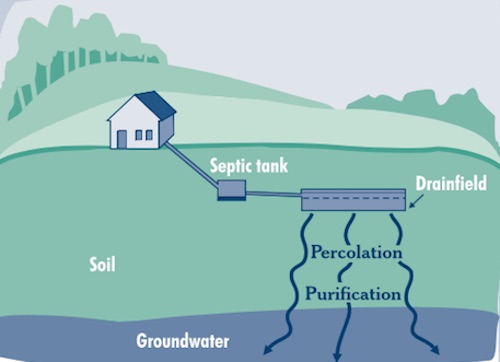The heart of your septic system, septic tanks breakdown the waste from your home. Most of the treatment takes place in the septic tank through naturally occurring organic processes—but, it doesn’t do all the work. Septic systems are a combination of pipes, a tank, bacteria and a drainfield that work together to treat solid and liquid waste before releasing it safely into the ground. Let’s take a closer look.
How Does a Septic Tank System Work?
A septic system is different than a water treatment plant in that it does all of the treatment and separation processes onsite.
Proven technologies mix with natural and biological processes to remove the wastewater from your home or business before releasing the treated wastewater into the soil.
But, the process only works if it has properly working components… so what makes up a septic system?
What Makes Up a Septic System?
There are lots of parts of a septic system, but they can be broken down into four main components:
- The Pipe from Home
- Septic Tank
- Drainfield
- Soil
1. The Pipes from Homes or Businesses
Waste and wastewater come from a number of sources in the home or business. Kitchen sinks, showers, toilets and appliances all lead out of the home into the septic tank via one pipe.
Additionally, most damage to the septic system comes from inside the home. Harsh chemicals kill off the naturally occurring bacteria in septic tanks. “Flushable” wipes clog the system. Dry-rotting drains cause foul smells. A good rule of thumb? Remember your septic system isn’t your garbage can.
2. Septic Tanks
The septic tank is where the magic happens and waste is treated in the septic system. Typically, tanks are made of concrete, fiberglass or polyethylene, the tank is watertight and buried under an out-of-the-way area. The tank holds wastewater deposited from the pipe long enough for separations to occur.
- Solids sink to the bottom of the tank and eventually combine with other solids to form a sludge layer.
- Buoyant grease and oils float to the top of the tank, combining to form a scum layer.
Septic tanks use natural processes and bacteria while breaking down waste. Aerobic bacteria use waste as fuel, turning the solids into liquids and gases through excretion. In fact, they are so efficient and resilient, healthy and happy bacteria decomposes up to 50% of the waste in septic tanks.
Compartments or T-Shaped tank designs keep the sludge and scum layers from exiting with the wastewater into the drainfield. Upon exit, recommended effluent filters further prevent any solids from exiting the tank.
3. Drainfields
Every time new wastewater enters the septic tank, wastewater also exits the tank into the drainfield. The drainfield is a shallow, covered excavated area at the exit of the septic tank. It is important to note, unsaturated areas are the only suitable place for a drainfield. Too moist of ground would not be conducive to the natural processes required in the drainfield.
If the drainfield becomes overloaded with an excess of wastewater or flooded with rainwater, the drainfield ceases to treat wastewater. Additionally, excess waters causes sewage to flow to the ground surface, creating backups in the system.
Each state requires different specifications when it comes to drainfields. In Florida, the land needs to be a minimum of twice the size of the drainfield. Additionally, minimum distances are dictated for distances from water retention areas, water wells, high-water lines, today areas and groundwater inceptor drains.
There are a variety of drainfields, all working towards the same goal. Each type is dependents on the space and landscape of the area of your septic system.
4. Soil
Technically part of the drainfield, the soil is the last barrier before wastewater enters the groundwater. It offers the final stage, of treatment. Wastewater percolates through the ground and is filtered by the porous soil. Soil eliminates harmful coliform bacteria and any remaining solids.
How Do You Take Care of Your Septic System?
Wondering how to take care of your septic system? Maintenance! And treating your septic system right with inspections, efficient water use, “do not flush” rules, and maintain the area surrounding the drainfield.
- Inspections and Pumping. With natural processes easily interrupted, septic tanks are fragile. Have a professional inspect your septic system at least once every three years. Septic tanks should be pumped once every three to five years.
- Use Water Efficiently. Invest in water saving appliances, low flow toilets, and high-efficiency shower heads.
- Follow “Do Not Flush Rules.” Your toilet and garbage disposals are not trashcans—treat them accordingly. Flush only toilet paper, avoiding “flushable” wipes. Afraid of guests during the holidays messing up the system? Put up some friendly reminders.
- Maintain the Drainfield. Keep tree roots away from the drainfield pipes. Divert rainwater and runoff from saturating the area.
- Avoid strong chemicals. Start looking for alternative cleaning products and detergents while avoiding products containing chlorine bleach
- Find a septic contractor and inspector you trust. Have a professional whose opinion matters goes a long way. They can help schedule maintenance and inspections while putting your mind at easy. But, it’s not always easily. Here are few qualities every septic contractor should have.
Septic systems are well-oiled machines designed for onsite treat wastewater. They function efficiently, as long as all of the components are working correctly and together. If your septic system isn’t working it’s best or for maintenance tips and a system inspection, call Advanced Septic Services at 352.242.6100.



